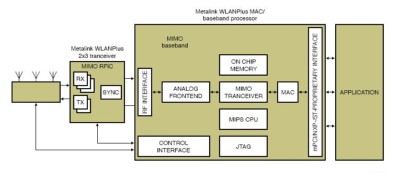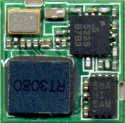802.11n zooms ahead
Jul 1, 2008 — by Eric Brown — from the LinuxDevices Archive — 2 viewsThe IEEE may be taking its time ratifying its 802.11n standard, but that does not appear to be slowing the momentum of the 300- to 600Mbps technology, says ABI Research. The market research firm forecasts 802.11n access point shipment growth from 6 million this year to 88 million in 2013.
The steep projected increase in “n” access point shipments will occur largely in 2009 and 2010, according to ABI. The research group predicts that by 2013, 88 million access points will ship with “n” technology, including 16 percent to “enterprise” customers.
The long-delayed, much debated 802.11n standard is expected to offer about twice the range of 802.11g, with better service quality and far greater bandwidth: from 300- to 600Mbps depending on the configuration. To achieve these speeds, 802.11n uses technologies such as “channel bonding” — borrowing bandwidth from an adjacent channel — and MIMO (Multiple-In-Multiple-Out) spatial multiplexing, which uses multiple radios and antennas to simultaneously process incoming signals and thereby improve clarity.
After much contentious debate, the first 802.11n draft, in May of 2006, was voted down, leading to confusion in the market, with several vendors marketing “pre-draft” 802.11n products. Since version 1.10 was approved in January 2007, however, the standards process has proceeded more smoothly, but the September 2008 ratification date estimated in late 2007 has already slipped to 2009. Still, the standard now appears to be solid enough that wireless vendors are moving forward with introducing new 802.11n products, expecting that minor firmware updates will adjust for any last minute changes.

NXP's MRX2000 block diagram
(Click to enlarge)
Announcements of Linux-compatible 802.11n products over the last year include:
- Cavium/Arada — In March 2007, fabless network processor vendor Cavium and WiFi software specialist Arada announced a jointly developed Linux-based 802.11n WiFi networking reference design.
- NXP — In June 2007, NXP announced a multi-chip 802.11n module called the MRX2000 (see diagram above). The Linux-compatible module is designed for consumer devices such as set-top boxes, digital media adapters, residential gateways, routers, and game consoles. Shipping now, the module is likely to be an offering of ST-NXP Wireless, a wireless joint venture between NXP and STMicroelectronics, which is due to set up shop in the next few months.
- Cirrus — In November, Cirrus announced it was beta-testing an 802.11n version of its Linux-based WiFi array. It also announced a research collaboration with Carnegie Mellon University (CMU) around 802.11n. In April, Cirrus announced benchmarks showing 200Mbps performance per radio, which it claimed to be the fastest 802.11n performance proven to date in the industry.

Ralink RT3080
(Click for details) - Ralink — In January, Ralink Technology announced it was sampling a pair of single-chip 802.11b/g/n wireless networking subsystems. The Linux-compatible RT3080 targets mobile devices while the RT3070 interfaces via USB, and targets PCs, access points, and other devices.
- Redpine — In January, fabless chip vendor Redpine Signals announced it was sampling an “ultra low power” 802.11a/b/g/n wireless networking processor suitable for use in MicroSD cards and mobile devices. The Linux-compatible LiteFi RS9110 utilizes advanced power management techniques spread over system, algorithm, and circuit levels, says the company.
- Asus — In June, Asus announced that its new Asus Eee PC mini-notebook models based on Intel Atom processors will offer 802.11n WiFi. The Linux-compatible Eee PC 901 and 1000 models will also offer WiMAX options, says Asus.
Stated ABI Research VP Stan Schatt, “802.11n will become the default Wi-Fi technology.”
Availability
The ABI Research study, “IEEE 802.11n Update, Forecast, and Vendor Evaluation,” is available now. More information may be found here
This article was originally published on LinuxDevices.com and has been donated to the open source community by QuinStreet Inc. Please visit LinuxToday.com for up-to-date news and articles about Linux and open source.